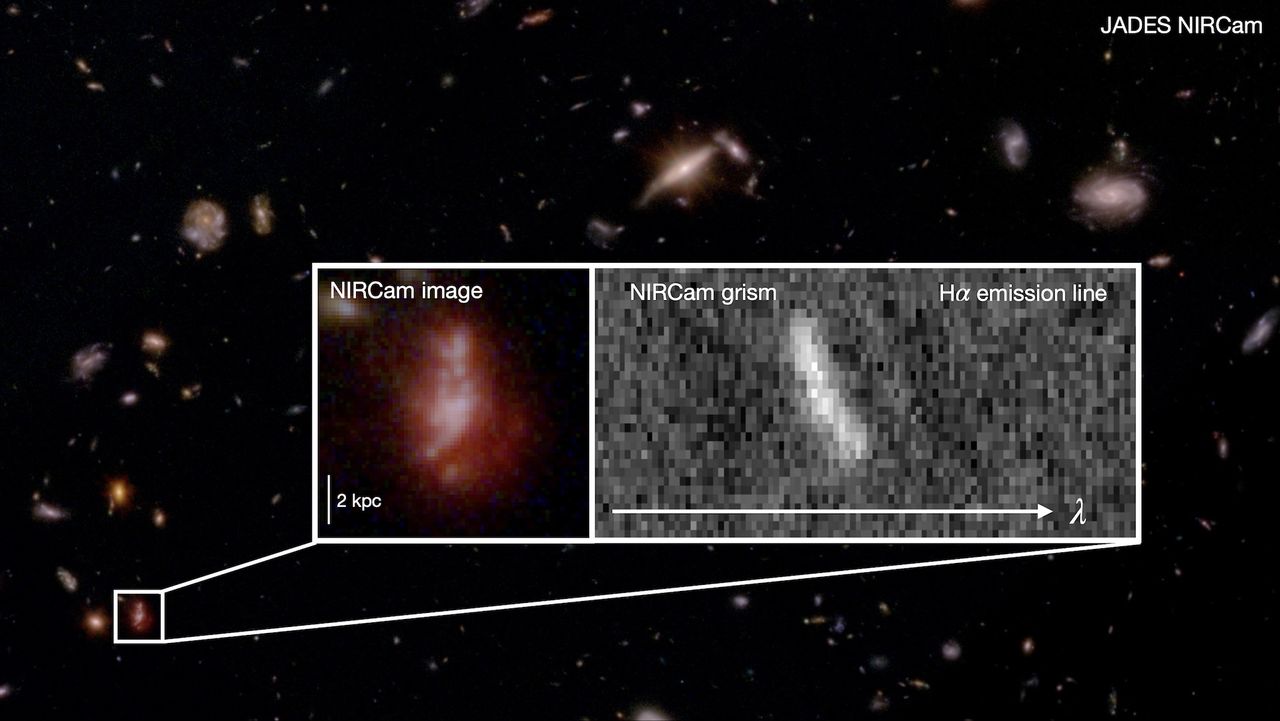Science
James Webb Telescope Reveals Chaotic Early Universe Galaxies

A new study utilizing the James Webb Space Telescope (JWST) has unveiled that galaxies in the early universe were significantly more chaotic than previously understood. By analyzing over 250 galaxies formed between 800 million and 1.5 billion years after the Big Bang, researchers discovered these celestial bodies displayed a level of turbulence and disorder not accounted for in earlier studies. The findings, published in Monthly Notices of the Royal Astronomical Society on October 21, 2023, challenge long-held assumptions about galaxy formation.
The research team, led by Lola Danhaive, a doctoral candidate at the University of Cambridge, focused on less massive galaxies, which typically exhibit what the scientists termed “messy kinematics.” Unlike the stable, rotating disks characteristic of galaxies like the Milky Way, these early galaxies were in a state of upheaval. Danhaive noted that previous studies concentrated on larger, more ordered galaxies, which are easier to observe, leaving a gap in understanding the dynamics of their smaller counterparts.
“The bulk of the galaxy population is undergoing a turbulent phase of its evolutionary history,” Danhaive explained. The intense turbulence observed during this period is largely attributed to high amounts of gas that fuelled vigorous star formation and resulted in gravitational instabilities. This turbulence, she added, was significantly underestimated in earlier research.
Transition from Chaos to Structure
The study also traced how these chaotic structures transitioned into the more organized patterns seen in mature galaxies. Danhaive commented on this evolution, stating, “At early times, galaxies are undergoing a turbulent phase of assembly, where strong bursts of star formation and high amounts of gas disrupt the ordered motions of the gas disk.” Over time, as galaxies accumulated mass, they became more stable.
The formation of structures like the Milky Way occurred much later, in the past few billion years, as available gas was consumed by stars, reducing the amount of free-floating gas. This reduction allows mature galaxies to evolve and change in a more orderly manner compared to their youthful counterparts.
The capabilities of the JWST were crucial for this research, as its position in a stable part of space minimizes interference from Earth’s stray light. The infrared telescope can penetrate deeper into the cosmos than its predecessors, frequently identifying some of the earliest galaxies known.
Future Research Directions
Looking ahead, Danhaive and her team plan to investigate the inflows and outflows of gas in individual galaxies. They aim to trace how gas becomes chemically enriched over time. Inflowing gas is expected to be less enriched, or “pristine,” while outflowing gas will likely contain more complex chemical components, influenced by stellar contributions within the galaxy.
Understanding these gas flows may provide insights into why certain galaxies rotate at different speeds. “There is so much more to uncover with JWST’s amazing capabilities, and we look forward to exploring many more aspects of early galaxy formation,” Danhaive remarked.
This study not only enhances our understanding of early galaxy dynamics but also sets the stage for future research that could further illuminate the complexities of the universe’s formation.
-

 Science1 week ago
Science1 week agoResearchers Challenge 200-Year-Old Physics Principle with Atomic Engines
-

 Politics7 days ago
Politics7 days agoNHP Foundation Secures Land for 158 Affordable Apartments in Denver
-

 Health1 week ago
Health1 week agoNeuroscientist Advocates for Flag Football Until Age 14
-

 Health7 days ago
Health7 days agoFDA Launches Fast-Track Review for Nine Innovative Therapies
-

 Lifestyle1 week ago
Lifestyle1 week agoLongtime Friends Face Heartbreak After Loss and Isolation
-

 Top Stories1 week ago
Top Stories1 week agoUnforgettable Moments: The Best Victoria’s Secret Performances
-

 World1 week ago
World1 week agoTroops to Enjoy Buffalo Chicken, Thai Curry in 2026 MREs
-

 World1 week ago
World1 week agoGlobal Military Spending: Air Forces Ranked by Budget and Capability
-

 Politics1 week ago
Politics1 week agoIsraeli Air Strikes in Lebanon Kill One, Wound Seven Amid Tensions
-

 Politics1 week ago
Politics1 week agoMassachusetts Lawmakers Resist Audit After Voter Mandate
-

 Business1 week ago
Business1 week agoMaine Housing Inventory Surges to Post-Pandemic High
-

 Lifestyle1 week ago
Lifestyle1 week agoJump for a Cause: San Clemente Pier Hosts Fundraiser Event








